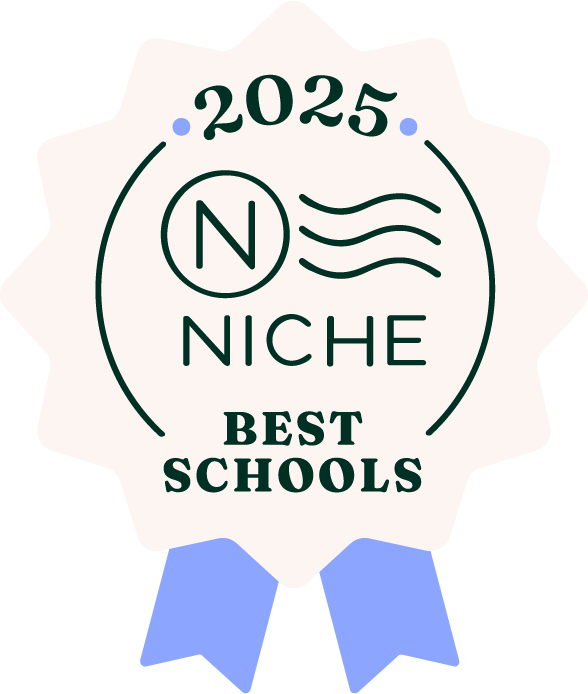 For this year’s Green and White Bash, Upper Elementary students took inspiration from the beauty and complexity of Greensboro Montessori School's gardens. As one of the room parents in Upper Elementary (my daughter, Stella, is a sixth-year student), I had the opportunity to work with my fellow room parents, Catherine Wolfe and Flory Hénon, to develop the classroom auction project. We chose to invite a collaboration between Environmental Education, Visual Art, and Upper Elementary to celebrate spring and to honor the spirit of Maria Montessori’s words about the importance of building a connection between children and nature. In 1936, Montessori wrote in The Secret of Childhood:
For this year’s Green and White Bash, Upper Elementary students took inspiration from the beauty and complexity of Greensboro Montessori School's gardens. As one of the room parents in Upper Elementary (my daughter, Stella, is a sixth-year student), I had the opportunity to work with my fellow room parents, Catherine Wolfe and Flory Hénon, to develop the classroom auction project. We chose to invite a collaboration between Environmental Education, Visual Art, and Upper Elementary to celebrate spring and to honor the spirit of Maria Montessori’s words about the importance of building a connection between children and nature. In 1936, Montessori wrote in The Secret of Childhood:
"There must be provision for the child to have contact with nature, to understand and appreciate the order, the harmony and the beauty in nature … so that the child may better understand and participate in the marvelous things which civilization creates."
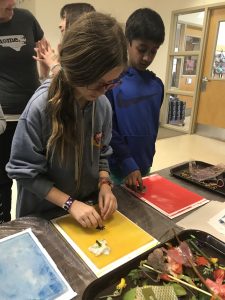 Our exploration of “the harmony and the beauty in nature” took the form of a printmaking workshop. Using gelatin plates, soy-based inks, found objects, and baskets of garden finds, we experienced nature’s beauty and fragility firsthand through art-making. Gelatin (also called “gel” or “gelli”) printmaking is a fun and safe monotype printing method used by both professional artists and weekend crafters. It is particularly well-suited to children, because gel plates and the water-soluble inks used in the printing process are nontoxic. It is also easy to achieve beautiful results, because the gel material is spongy and shows even small details of the objects being printed.
Our exploration of “the harmony and the beauty in nature” took the form of a printmaking workshop. Using gelatin plates, soy-based inks, found objects, and baskets of garden finds, we experienced nature’s beauty and fragility firsthand through art-making. Gelatin (also called “gel” or “gelli”) printmaking is a fun and safe monotype printing method used by both professional artists and weekend crafters. It is particularly well-suited to children, because gel plates and the water-soluble inks used in the printing process are nontoxic. It is also easy to achieve beautiful results, because the gel material is spongy and shows even small details of the objects being printed.
Our printmaking day began in the morning with Eliza Hudson, Greensboro Montessori School’s lead environmental educator, taking several student volunteers into the Upper Elementary garden to collect fresh materials. They gathered an exciting assortment of flowers and herbs bursting with the colors and textures of spring. Later in the morning, I arrived to set up our printmaking workshop. As I prepared the area for working, many curious students stopped by to see what was happening. Some poked at the squishy plates; others picked through the assortment of materials on display. I enjoyed seeing their curiosity piqued, even though we had yet to begin the actual printmaking. Catherine arrived soon after me, and together we inked each of three gel plates with a different color. We chose deep blue, reddish-pink, and an ochre yellow — all the way around the color wheel! — to represent the wide spectrum of colors found in nature. Once everything was ready to go, the teachers sent us groups of students by grade level during their recess.
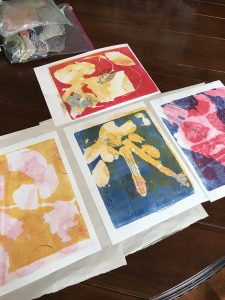 The sixth-grade students arrived first. They were quick to organize themselves: three students lined up in front of the gel plates while the other students crowded around to watch. They chose garden materials and recycled objects, then arranged them into compositions on the inked plates. We took preliminary prints, with the objects still on the plates, that resulted in strong, saturated colors and amorphous drifts of white left behind where the objects blocked the ink. We discovered that these prints made perfect background layers for prints taken of the detailed images left in the ink once the objects were removed. Sometimes enough ink remained on a plate after pulling these two prints to allow for a third “ghost” print that the students could use as yet another layer. In this way, each final print was created as the result of multiple rounds of printing through student collaboration. The shapes and colors on each print intertwined to create a beautiful and organic complexity, mimicking that which is found in nature. The students enjoyed the process of working together with their fellow students, and over time, began to design their prints collectively, keeping all of the layering possibilities in mind.
The sixth-grade students arrived first. They were quick to organize themselves: three students lined up in front of the gel plates while the other students crowded around to watch. They chose garden materials and recycled objects, then arranged them into compositions on the inked plates. We took preliminary prints, with the objects still on the plates, that resulted in strong, saturated colors and amorphous drifts of white left behind where the objects blocked the ink. We discovered that these prints made perfect background layers for prints taken of the detailed images left in the ink once the objects were removed. Sometimes enough ink remained on a plate after pulling these two prints to allow for a third “ghost” print that the students could use as yet another layer. In this way, each final print was created as the result of multiple rounds of printing through student collaboration. The shapes and colors on each print intertwined to create a beautiful and organic complexity, mimicking that which is found in nature. The students enjoyed the process of working together with their fellow students, and over time, began to design their prints collectively, keeping all of the layering possibilities in mind.
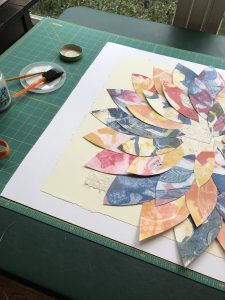 Upper Elementary students of all levels enjoyed the activity and many wanted to spend additional time making prints. I loved watching their faces as they pulled a fresh print off the plate. Their eyes would grow with excitement, and occasionally I’d even hear a gasp. The teachers were equally fascinated by the process. Katherine Gwynn, Greensboro Montessori School’s visual arts faculty, along with Eliza and the Upper Elementary faculty visited to observe and participate. Cathy Moses took photos and John Archambault partnered with a student to make a set of prints. When all of the students were finished with their work, we cleaned the area, and I packed up the prints to take home. In my studio, I combined and transformed them into the petals of a large, three-dimensional flower — a nuanced and strikingly beautiful tribute to spring that showcases the diversity found in nature and also among the children who dwell in it here at Greensboro Montessori School.
Upper Elementary students of all levels enjoyed the activity and many wanted to spend additional time making prints. I loved watching their faces as they pulled a fresh print off the plate. Their eyes would grow with excitement, and occasionally I’d even hear a gasp. The teachers were equally fascinated by the process. Katherine Gwynn, Greensboro Montessori School’s visual arts faculty, along with Eliza and the Upper Elementary faculty visited to observe and participate. Cathy Moses took photos and John Archambault partnered with a student to make a set of prints. When all of the students were finished with their work, we cleaned the area, and I packed up the prints to take home. In my studio, I combined and transformed them into the petals of a large, three-dimensional flower — a nuanced and strikingly beautiful tribute to spring that showcases the diversity found in nature and also among the children who dwell in it here at Greensboro Montessori School.
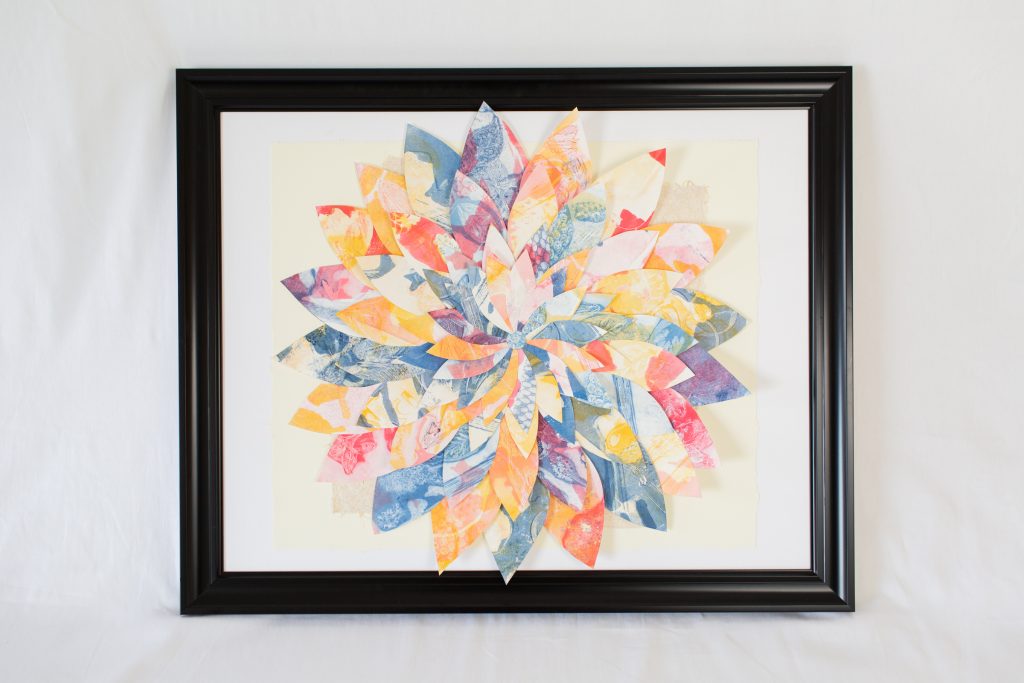
Acknowledgements
This project came together with the help of several important collaborators. First, thank you to Eliza Hudson for taking volunteer students into the garden on a beautiful spring day to collect flowers and herbs, the stars of this project! Thank you also to Katherine Gwynn for her enthusiasm and for placing an emergency order of paper for us. Many thanks to the Upper Elementary teachers, Cathy Moses, John Archambault, and Tessa Kirkpatrick, for weaving our project into a busy school day. And, finally, thank you to my year-long collaborators in Upper Elementary, fellow room parents Catherine Wolfe (who is also the division coordinator) and Flory Hénon, for their excitement about the project and their support during the printmaking workshop.
 About the Author
About the Author
Gina Pruette is a parent and substitute teacher at Greensboro Montessori School. In addition to helping at the School, Gina enjoys tackling creative challenges as a freelance copy editor, writer, and visual artist. She is writing her first book, a guide to collaborative art-making with children, with the hope of encouraging more parents and educators to make art with the children in their lives. This summer, Gina will teach bookbinding methods during the School’s GMS Press book-themed camp. You can find her on Twitter and Instagram. She holds a bachelor of arts from the University of Pennsylvania.


